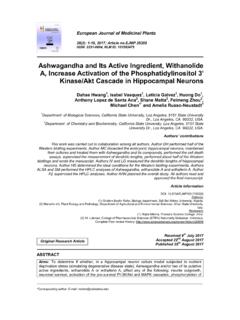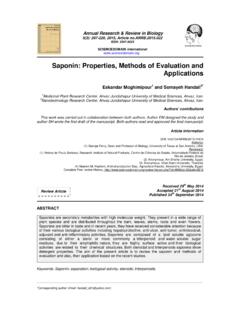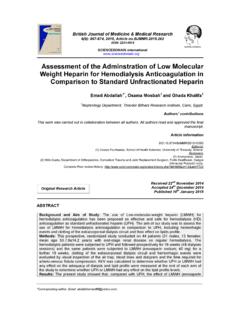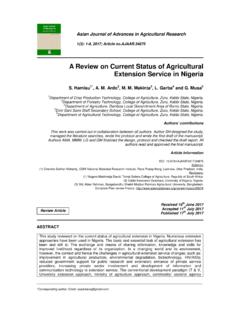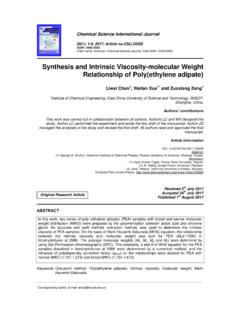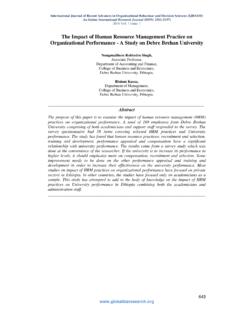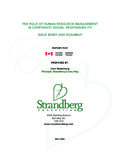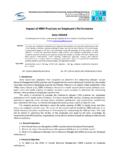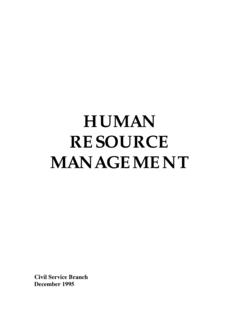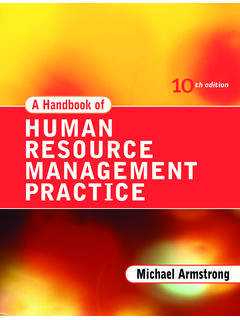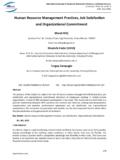Transcription of Human Resource Management Practices and …
1 _____ *Corresponding author: E-mail: Journal of Economics, Management and Trade 18(2): 1-10, 2017; Article Previously known as British Journal of Economics, Management & Trade ISSN: 2278-098X Human Resource Management Practices and Employee Retention: A Review of Literature Shaheeb Abdul Azeez1* 1 Department of Public Health, Faculty of Health Sciences, The Maldives National University, Republic of Maldives. Author s contribution The sole author designed, analyzed and interpreted and prepared the manuscript. Article Information DOI: Editor(s): (1) Stefano Bresciani, Department of Management , University of Turin, Italy. Reviewers: (1) Rajwinder Singh, Punjabi University, Punjab, India. (2) Noorziah Mohd Salleh, Universiti Teknologi MARA, Malaysia.
2 Complete Peer review History: Received 27th March 2017 Accepted 4th May 2017 Published 23rd June 2017 ABSTRACT Human Resources (HR) are the most valuable asset in any organisation. Even though organisations advanced with technology, they need HR to run the technology. With this advancement in the industries completion among the organisations are very high. This opens many pathways and opportunities in the hands of the HR. The major challenge by most of the organisation today is not only managing their workforce but also retaining them. Therefore, securing and retention of skilled workforce plays a vital role for any organisation due to knowledge and skills of the employees are central to the institution s ability to be economically competitive for growth and sustainability.
3 Additionally, employee satisfaction is another HR issue faced by the employers today. When taken to account the importance and sensitivity of the issue retention to any organisation, this study is aimed to identify the relationship between HRM Practices and employee retention based on the literature review. Keywords: HRM Practices ; job satisfaction; employee retention. Review Article Azeez; JEMT, 18(2): 1-10, 2017; Article 2 1. INTRODUCTION Turnover of skillful employees is a major concern of managers and administrators in today s business world due to the costs incurred to replace and lost productivity of them. Employees leave their jobs due to many reasons, but research has shown the following as primary reasons; conflict or dislike of boss or supervisor, not fitting into the organizational culture, or being attracted to another employer who meets the expectations of employees [1].
4 Therefore, reducing employee turnover by means of effective retention Practices is the most important area of interest to any organisation with highly skilled labour force. Turnover can be either voluntary or involuntary. Voluntary turnover is a decision by an employee to break the relationship with his or her organisation. This happens when the employee chooses to leave the organisation. In such a circumstance, the organisation loses a valuable employee and his skills and talent need to be replaced. Involuntary turnover means an employee being terminated by the organisation. It happens due to many reasons such as decline in revenue of the company, retirement, resizing, restructuring, etc.
5 In every case, an employee leaving either voluntary or involuntary is not due to a negative relationship with the organisation. In addition, involuntary turnover is unavoidable, where it is a part of business cost and life [1]. The current workforce combines with four distinct generations which include the traditionalist, the baby boomers, the Generation Xers and the Millennials or Generation Yers [2]. Each generation has its own distinct features which describe the characteristics of the people and societal changes that shaped them [3]. Their needs vary according to their generation. For instance, the concept of work-life balance is one of the major concerns in the workplace by Generations Xers and Yers compared to the traditionalists and baby boomers.
6 For the first two generations, work is the most important aspect of their life, while life is the most important reigns for the Generation Xers and Yers. It is also clear that Xers and Yers highly value their personal time over company time [4]. Having said so, generational differences can be either an obstacle or a means to improve organisational performance. Managers and organisations need to develop and utilize multimodal Human Resource Management (HRM) strategies to get the maximum benefits out of their employees. Organisations have to find ways to best utilise their people such as using the work ethics and expertise of baby boomers to train and educate the younger employees. Meanwhile, to earn the trust of the Xers organisations can encourage their participation in organisational growth and to lead the business into meeting future targets.
7 At the same time, organisations must develop the Yers too by providing continuous guidance and encouraging them to take part in non-virtual teams [4]. This will help to establish well-organised and highly motivated teams within the organisations, leading to lower turnover. The prime goal of a successful employer should be the acceptance and use of generational differences in their business growth and development through creating an effective workplace, which leads to reduced turnover. Objectives of the Study This study on review of literature on retention initiatives undertakes the following objectives: 1) To find out the various research works that have been done in the area of HRM Practices and employee retention.
8 2) To highlight the various factors which affect retention initiatives in an organisation. 3) To explore the relation between HRM Practices with job satisfaction leading to employee retention. 2. METHODOLOGY The study is descriptive in nature and only secondary data have been used in it. The secondary data consists of the books and various research journals. 3. EMPLOYEE RETENTION Employee retention refers to the hierarchical arrangements and Practices utilised as a part of the organisation to keep key workers from leaving the association. Employee retention is the exertion by a business to keep attractive labourers with a specific end goal to meet business targets (Frank et al.
9 , 2004 cited in Natalie et al., 2011) [5]. Employee retention is keeping the capable well-performing employees in the organisation for a longer period to achieve competitive advantage. As per Berry and Morris ([6], p. 2) retention is a continuation of the employment of the workers, particularly high- Azeez; JEMT, 18(2): 1-10, 2017; Article 3 calibre and productive workers. Employee retention in an organisation relies upon the way the organization maintains its HRM Practices to discuss the issues and requests of its employees. However, retention is multi-dimensional factor of an organisation s Human Resource policies which begins with recruiting the right people in the organisation and to stick them with the organisation s business portfolio (Freyer, 2014 cited in Madiha et al.
10 , 2009 cited in Fatima, 2011) [5] (p. 9). In addition, the authors discussed a range of retention strategies, including bonuses, promotions, and personal communication from top managers. They also discussed whether retention bonuses should be tied to performance and offer suggestions for implementing performance-based rewards [5] (p. 11). The idea of employee retention begun during 1970's and mid 1980's while people and organisations are unaware of the importance keeping the potential employees and its advantages to the organisation. Before that, as usual people join the organisation to earn to meet their daily needs; they stay longer time in the organisation and even for their work life.


